Iowa and Nebraska (Dennison, Omaha, Missouri Valley, Council Bluffs)
September 1, 1913
Broke camp early and ran to Omaha, through Missouri Valley and Council Bluffs, reaching Omaha at 2:00 p.m. A Labor Day celebration was in progress. At Missouri Valley we had two punctures – the first on our trip. Elizabeth was sick most of the day but kept up bravely. The last eight miles of road into Council Bluffs was as bad as anything we found on the whole trip with the possible exception of New Pass in Nevada. In the hills the dry clay had been churned into a bottomless dust that filled horrible chuck holes. How we ever got through it without wrecking the car is a mystery. We took rooms at the Wellington on Farnam Street above the Court House.
Day’s run – 77 miles
Nebraska (Omaha, Fremont)Tuesday
September 2, 1913
We spent most of the day buying a moving picture outfit for which we paid $123 .55 all told from the Omaha Film Exchange, A.C. Haitman, Manager, 14th and Douglas. We also bought a lantern ($1 .25) and a folding spade ($1.30), etc. The weather was intensely hot, 100 in the shade, and at 4:00 p.m. we were off again to the west. Just outside the city we ran through a violent rain and wind storm, but finally got out of it, and at 7:30 p.m. we went into rooms at Fremont, Nebraska on account of threatening weather.
Day’s run – 40.5 miles
Nebraska (Fremont, Grand Island)
Wednesday September 3, 1913
We left Fremont at 7:00 am. and a little later camped for breakfast. Later on in the morning we met a party in a Hupmobile bound for Los Angeles, a Mrs. East and son Fred of Omaha with a chauffeur named Yates. The roads were for the most part fine all day with occasional patches of sand that covered chuck holes. During the day we overtook two other Iowa cars bound for Douglas, Wyoming. At 6:30 p.m. we camped with the Easts four miles west of Grand Island. It was a lovely night, and we were near the home of a hospitable farmer who took a good deal of interest in our trip.
Day’s run 130.6 miles
Nebraska (Grand Island, Gottenburg, North Platte, Cozad, Willow Springs)
Thursday September 4, 1913
We broke camp at 8:00 am. and ran over almost perfect roads all day until just after the Platte River at Gottenberg where they became increasingly bad. The country side was getting very bare and houses were very few and far between. At 6:00 p.m. we went into camp about eight miles east of North Platte in a shaded lane leading up to a ranch house a half mile beyond. There was a post office there called the Inland Post Office that apparently served one or two shacks. The Easts camped near us. During the day between Cozad and Willow Springs we passed two young fellows who were crossing the country on Foot. They were from Buffalo, N.Y. and were pushing a push cart containing all of their personal effects.
Day’s run – 147 miles
Nebraska (North Platte, Southerland)
Friday September 5, 1913
We broke camp early and by 8:30 a.m. we were in North Platte. We camped on a street well out of town and repacked our stuff. Part of the motion picture equipment was expressed here, and we shipped some of our own gear ahead to Cheyenne. Then we drove the 20 miles to Southerland and rented the “Opera house”. We then billed the town, sold tickets, and tried to put on a picture show. After some hours of work, we had to give up, return ticket money to the audience, and camped on the edge of town thoroughly discouraged.
Day’s run – 44 miles
Nebraska (Ogallala, Big Springs, Sidney, Six Station)
Saturday September 6, 1913
We left our shaded, secluded camp at 8:30 a.m. and got on the Transcontinental Highway. We traveled on roads that for the most part were excellent. In the sand hills gear Ogallala we encountered a gentlemen with a broken Ford car. He had struck an outcropping in the middle of the road and smashed his axle. Later we found a man from Webster in trouble with his tires and a Ford from Ottumuwa stalled by reason of smashed ball bearings. Our Studebaker had trouble with a leaky water tube. The countryside was now growing into wide bare plains and hills. At Big Springs we ascended to a high plateau which the government survey post showed to have an elevation of 3,700 feet. The corn growing in the plains looked very bad due to the drought. At Sidney we met a gentleman in an EMF who was starting in a week for Los Angeles. The sky looked stormy, and at 3:30 p.m. we went into camp in a pleasant school house yard near Six Station. We had a big stew made from rabbits and doves we shot during the day. The wind blew hard during the night but it did not rain.
Days run – 132 miles
Wyoming, Colorado (Cheyenne, Fort Collins, Loveland)
Sunday September 7, 1913
We left camp at 8:00 am, and promptly b1ew out a front tire. We put an old one on in its place. We reached Cheyenne at 1:30 p.m. Two or three miles out of Cheyenne we had a narrow escape from a wreck! Howard looked over the side of the car and noticed the rear wheel rim was wobbling. When we examined it, we found that it lost all but one of the lug nuts. It was remarkable that we did not have a serious accident. We “borrowed” nuts from the other wheels, and at Dildrines Garage in Cheyenne, we purchased three so we could get to Denver. After dinner at a cafe, we started for Denver, but we made a wrong turn and went to Fort Collins and Loveland instead. The old tire that we put on the front axle blew out just before we got to Fort Collins, and a great storm raging in the mountains off to our right filled us with alarm. After repairing the tire, we ran through very fine country to Loveland where we stored the car and took rooms at the Beckwith House.
Day’s run – 136
Colorado (Loveland, Denver)
Monday September 8, 1913
We left Loveland after breakfast and ran on fair roads through fine fruit country to Denver. We got there at noon and had luncheon at the Iowa Cafe after visiting the bank. We then went to the Pantages Theater and received instructions from the operator there on how to operate our motion picture equipment. We secured a new Federal tire for $10.00 in exchange for the old one. In the late afternoon we took a long drive through the city and the park. We accidentally ran across the East party again and visited Chasbrough Park with them. We returned to our rooms at the Reo on Broadway, and after supper we went down to the brilliantly lighted center on 17th and Curtis and took in a couple of moving picture shows.
Day’s run – 70.6 miles
Colorado (Denver, Greely)
Tuesday September 9, 1913
We slept in rather late. It might be noted that when we stopped at hotels during our trip, we were glad to indulge in baths which we all appreciated. Kenneth and I secured supplies for the trip. After luncheon, I secured the seven tubes I had left to be repaired. We then drove to the city park and then on to the DeSato Hotel where we saw Sam Fisher, formerly of Eldora, who escorted us for some miles out of town to show us the way. For the first 20 miles, the road west was very bad. It was rough and cut up by workmen. Then it got very good; it was graveled and in fine condition to Greely where at 8:00 p.m. we stopped for the night, taking rooms at the Chapman House. Elizabeth had a bad cough which required us to stop as early as we did.
Day’s run – 65.5 miles
Colorado and Wyoming (Greely, Cheyenne, Granite Canyon)
Wednesday September 10, 1913
We left Greely after break fast over roads that had been softened by heavy rains the day before. It might be noted right here that with the exception of two light showers, we had no rain during the entire trip. It rained heavily ahead of us at times but the roads were generally perfectly dry for us. On the way to Cheyenne, which we reached at 12:45 p.m., we passed an old man, a tramp, who wanted a ride, but we were so heavily loaded, I refused. After that we had a standing, joke about “the poor old man” which we worked with every variation. In Cheyenne we had the motion picture screen laundered, put in supplies, repacked our stuff at the train depot and checked some on ahead. We bought an alcohol stove and at 4:00 took to the road again and headed for Salt Lake City, along the line of the Union Pacific. We got caught in a little shower which we sat out with our backs turned to it. At 5:15 p.m. we went into camp at a stone school house half a mile or so beyond Granite Canyon. It was a picturesque spot, and as there was a supply of coal handy, we had a big fire.
Day’s run – 81.6 miles
Wyoming (Sherman’s Pass, Ames Monu-ment, Laramie, Rock River, Medicine Bow)
Thursday September 11, 1913
We could hear the coyotes howling and realized that we were really getting into the far west! We kept a good fire going with the coal we obtained from the little school house coal bin. The kids, without doing damage, entered the school house through the window and explored the library and played with a little organ. Our camp site was located in a wild, desolate place with-out a house in sight and only the rugged hills all about. We got up early to a heavy fog which we feared might turn into rain. As we drove up the wild mountain grades the fog lifted but the cold increased. The summit, Sherman’s Pass, was at an altitude of 8,200 feet, and we passed the Ames Monument. The sun came out just as we came into view of the Monument – a lonely sentinel in this high place. Then, by easy stages, we dropped down to excellent roads with broad landscapes all about us, rugged rock formations, and pine-clad hillsides. There was always something to attract our interest – a group of stunted cedars, some odd and grotesque rock formations, or sheltered valleys among the high peaks. We reached Laramie about 10:30 a.m. and made Lovejoy’s garage our headquarters. From there we followed the new Trans-continental Highway that followed Union Pacific tracks through Rock River and reached Medicine Bow at 5:00 p.m. We shot a jack rabbit and sonic cottontails and had a little dash of rain. Medicine Bow, a typical “frontier” town of a few houses and a couple of saloons, gave us a nice surprise: a modern, three-story hotel called “The Virginian” that was owned by Gus Grimm. This entertaining individual had “blown in” as a hobo a few years before, got hold of a saloon without a cent to his name, and made a lot of money. He owned the hotel, the electric light plant, saloon, and everything else in town. We tried to put on another picture show and billed the town, but as usual, we could not work the apparatus. We had to return $35.00 to a disappointed audience and gave up in disgust. Mr. Grimm and I had worked until 2:00 o’clock in the morning, and we went to bed terribly disappointed.
Day’s run – 99.6 miles
Wyoming (Medicine Bow, Carbon, Hannah, Rawlins, Warnsutter)
Friday September 12, 1913
A little after 8:00 a.m. in the morning after breakfast, we paid for our lodging at the Virginian (a total of $7.50) and got away from Medicine Bow and headed west. We drove through the deserted town of Carbon – an extensive town without a single inhabitant. Every house was deserted and going to ruin. We then reached Hannah where great mines are operated. The whole country was alive with jack rabbits, and Kenneth shot some and a sage hen as well. Saratoga, which was 20 miles north, is a famous hunting and fishing resort. At Rawlins, we laid in supplies and expected to go into camp early. We were running along a road that was good except for transverse ditches that cut across it where rains had washed them out. They were narrow and deep and could scarcely be seen until one got right on them. The road continued over a high plain that was covered with sage brush. About fifteen miles out of Rawlins we dropped into one of these ditches with a terrible crash, smashing the windshield, tearing the trunk rack loose, and starting a leak in the gasoline tank. After surveying the damage and fearing to lose all our gasoline while out in this deserted wilderness, we decided to press on to Wamsutter, about 23 miles distant. The roads were very bad. One part of the road followed the top of an old railroad grade. As night came on, we almost ran into a deep gully where a bridge had been taken away. No barrier had been put up to show that there was a detour. At last, after dark at 8:30 p.m., we pulled into the town of Wamsutter and pitched camp in the sage-brush just outside of town. We had rabbit stew and rolled up into our blankets for the night.
Day’s run – 106.4 miles
Wyoming (Point of Rocks, Salt Wells)
Saturday September 13, 1913
At 8:15 a.m. we were on the road again, and such roads! Hideous for the most part – deep narrow gullies or trenches across them every twenty feet or so into which the wheels would drop with a sickening thud. We had one radiator leak that did not appear to be serious, but the water pump was leaking badly also. This bothered us all the way across. It was impossible to keep the radiator full of water. At Point of Rocks – a few houses by the railroad clustered in a deep ravine – we put in seven gallons of gas, visited a kindly old storekeeper named Galvin Hasson who has a son living somewhere near Los Angeles, and then went on. The road crossing the railroad tracks winds sharply through the hills at a stiff grade. We got to the top of the grade and were going along the level at a fairly lively pace when there was an awful jar, and the car came to a stop! We got out and found that the tie rod on the left side of the car had come loose at the forward end and had been thrust into the ground to a depth of at least two feet! It was a great wonder that it did not upset us! We had to dig it out of the hard soil, badly twisted of course, tie it up, and go ahead slowly. We went on for a few more miles when all of a sudden the car came to a complete stop with a sickening crash and jar, and we failed in every effort to move it. The road ran close to the north side of the Union Pacific tracks, and about a mile on further was the Section House at Salt Wells. Here we found a mechanic named Charlie who tried to help us, but all was in vain. At last it was decided to send Kenneth to Rock Springs by the 10:30 a.m. train which was accordingly signaled and took him on board. The rest of us camped by the car on the road-side. Mother, Elizabeth, and Howard slept in the car, and Charles and I slept on the ground by a campfire made of old railroad ties which we gathered among the sage brush. It threatened rain all night, and there was a light shower in the early morning.
Day’s run – 57 miles
Wyoming (Rock Springs)
Sunday September 14, 1913
We cooked a teal duck which Kenneth shot yesterday, and then at the Section House, a nice woman baked us a batch of biscuits, a couple of gooseberry pies, and gave us some butter. I paid her a dollar for the lot. At about 10:30 a.m. Kenneth came back in an auto with a mechanic who proceeded to disconnect the gears and take us in tow. We all had to get out and push the car over a couple of sharp little hills, and it was a tight squeeze even then. We finally reached Rock Springs, the great little mining town of Wyoming. We put up at the hotel near the railroad while the Western Auto Transit Company took charge of the car. We met Reverend A.P. Shepp, an Episcopal minister, who, besides being a very kindly and agreeable man, was full of interesting reminiscences.
Day’s run – 12 miles
Monday September 15, 1913
During the day, while waiting for repairs to be made, I visited the office of “The Miner”, but the editor was away on a hunting trip. I called on Banker Hay, a cousin of Senator Borah, who was anxious for me to locate there, and, I, think, if the editor of the paper had been in town, I might have arranged to get hold of the paper. I also met the mayor of the town. At 5:30 p.m. the repairs were completed, and we loaded up and started off. Just before we pulled out, an auto hearse drove in bound from San Francisco to New York with the body of some auto enthusiast who had requested that he be taken across that way. He undoubtedly found it to be a rough trip. The driver of the hearse did not add anything to our peace of mind by his accounts of the rough road he had just crossed. At almost dark we camped under a bluff at the right of the road five miles west of Rock Springs. A high wind was blowing.
Day’s run – 6.8 miles
Wyoming (Bryan, Granger, Black River)
Tuesday September 16, 1913
We left camp at 8:30 a.m. and drove to a Section House at Bryan. We found three cars that had stalled and were in need of repairs. One, a big Auburn, had attempted to pass a Ford at a cutoff and had gone into deep water and blown its engine. The occupants were waiting for repairs and were making the best of it – a very merry party. A little further on we met a man and his wife in a auto from Idaho bound for Florida via Indianapolis. He reported dreadful roads ahead. The road we were on improved as we got closer to Granger, which we reached about 1:00 p.m. after circumventing an enormous gravel pit. We stocked up at Granger and then headed off for Salt Lake City. Early in the afternoon, while on a fairly good road except for occasional gullies caused by recent cloudbursts, we came to Black River, a beautiful stream fringed with birch trees. It was such a tempting place that we made camp, cooked three rabbits, and prepared to be comfortable. Kenneth got out his fishing tackle, but the fish grabbed his hooks off as fast as he could throw them in. We all enjoyed the campsite very much. In the evening we had an immense campfire that must have been visible for miles.
Day’s run – 59.4 miles
Wyoming (Black River, Lyman, Fort Bridger, Evanston, Castle Rock Station)
Wednesday September 17, 1913
We found the night pretty frosty, and we all got up early. A thick, white frost covered our bedding. The night in this high altitude was wonderfully beautiful. Not a cloud in the blue and a full moon all night among the myriad stars. The elevation here is approximately 7,000 feet. The sun came up about 6:00 a.m. and a big fire soon warmed us. Just after break-fast, we heard a couple of shots, and the East party came along again! We were all very glad to see them. They came to our camp and had coffee with us. An hour later we all set off again together at 9:30 a.m. We drove though Lyman and historic Fort Bridger where ruined houses still stand among the trees. Then onward to Evanston where we laid in supplies. Here fine irrigation ditches ran beside the road. About a mile later, we passed Castle Rock Station and camped on the hillside overlooking the bottom lands of the railroad. We built a big fire of logs and sat about talking and singing while the boys explored.
Day’s run – 76.4 miles
Wyoming and Utah (Castle Rock Station, Coalville, Salt Lake City)
Thursday September 18, 1913
There was heavy frost again, but the night was beautifully clear. Mrs. East walked to the station for eggs and milk, and we all had breakfast together. We got underway at 9:00 a.m. and the road was rather bad for the first mile or two. After that, we drove all day through the most wonderful scenery to Salt Lake City. We drove through Webber and Echo Canyons. There was always a little stream nearby as well as great walls of seamed red rock. The crests and sometimes the sides of the rock were covered with foliage which contained the dazzling yellows and scarlet of autumn. Some of the trees were veritable masses of flame. We were continually entranced by the scenery. At Coalville, we stopped beside the shady road for lunch and were overtaken by an Australian. a Mr. H.A. Tippes of Sidney, who was finishing, a five year trip around the world on a bicycle! He started his trip in 1908 and amused us very much. We finally went over the great pass and then down the splendid grade where we coasted for five or six miles. Our only stop was at a wayside inn. We reached Salt Lake City at 5:00 o’clock. We installed ourselves in a fine apartment at the Rex. We were very comfortable while repairs were made on our machine.
Utah (Salt Lake City)
Friday September 19, 1913
We spent the day in Salt Lake. A Mrs. Richmond and Mrs. Snell called on Mrs. Kneedler. We also attended a noon organ recital at the Tabernacle and spent the evening with the Richmonds in their home. Afterwards, we went with Mrs. East to the Rathskeller and listened to music.
Saturday September 20, 1913
We spent the day in the city, took dinner with the Snells and spent the evening there.
Utah (Salt Lake City, Saltair, Grantville)
Sunday September 21, 1913
We made some final repairs on the car, had breakfast, and laid in a stock of provisions. (Hotel bill $9.00, Laundry $8.10). At 10:00 a.m. we got started. The East party accompanied us. We had quite a little trouble getting out of town and drove to Saltair where, though the season was over, the bath house was open, and we all went bathing in the wonderfully clear saline waters. Then we headed west again and ran through the scattered town of Grantville and camped by the roadside under a row of great poplars. It. was stormy looking and the wind was blowing, but we got a fire going. It rained some, and Charles, Kenneth, and I crawled into a little tent that the Easts had with them. Mary, Elizabeth, and Howard slept in the auto. A new party was with us at the time, a one-armed man and his wife, the G.P. Wolletts of Ottumuwa, whom we met after leaving Saltair. At the time we enjoyed them, but they became a source of annoyance and later disrupted the party. She, particularly, was not congenial.
Day’s run – 57 miles
Utah (Grant City, Caldwell, Kanaka Ranch)
Monday September 22, 1913
We got up to find that the nearby mountains were covered with snow, and there were heavy storm clouds. A strong wind was blowing, and there were dashes of rain. We obtained provisions in town, and I found a druggist whom we had known in Caldwell, Idaho. At 10:00 a.m. we were off and found the road very soft and rough. At certain places, all the cars on the road skidded badly, and finally, after making about 8 miles, we camped on a hillside. We stayed there for a couple of hours and waited until the bright sunshine and cool breeze dried off the road a little. With a little fire going, we could look off from our lofty perch to the barren flats and the great Salt Lake. When we got under way again, the East’s Hupmobile broke a spring, and we stopped at Kanaka Ranch, 80 miles from Salt Lake. This is a big ranch operated by Mormons and settled by people from Hawaii and Samoa. It is under the management of W.M. Waddoups, a very kindly, young man. There were 120 Hawaiians and two white families. We camped in a grove east of several big barns.
Day’s run – 32 miles
Utah (Kanaka Ranch)
Tuesday September 23, 1913
We could hear rain falling in the early morning. We were sleeping in the hay in the big barns, and when we got up, the ground was covered with about three inches of snow. By 8:00 o’clock, the sun came out and a thaw set in. All day cloudiness alternated with sunshine, and we were not at all comfortable. We all had a big dinner at the home of Manager Waddoups, then a big campfire, after which we retired to the hay. Charles and Fred East preferred a sheep herder’s wagon that was in the corral. Alfred Kennison, a Samoan, gave Elizabeth a couple of beautiful bead necklaces that he brought from his South Pacific home.
Utah (Kanaka Ranch, Indian Village, Olds’ Ranch)
Wednesday September 24, 1913
The sun was shining brightly when we got up at 7:00 a.m. and we packed up and were ready to start at 10:00 a.m. just as we were leaving, the Fasts’ Hupmobile broke down, and we were stuck all day until 5:00 p.m. before they could get it going. In fact, we probably would not have been able to leave then if two young mechanics in a Ford had not come along. They were from Grundy Center and on their way to Los Angeles. Their names were Charley Home and Clyde Hamilton. They took the engine completely down and put it back together again. Finally at 5:00 p.m. we were off again over pretty bad roads. We passed through Indian Village after taking down and putting up numerous gates in fences. We camped at Olds’ Ranch. Another party bound for the east coast occupied the only spare room in the log cabin. It was a typical frontier home. Near the house was a running stream and a pond. There were large hay ricks and a good deal of stock. The Wooletts (the party going east) curled up in their auto which was fitted with a bed (the seats reversed). We then gathered around the campfire and Mary [Mrs. Kneedler], Mrs. East, and the kids made a bed on the side of the hay. They spent a cold night occasionally interrupted by the visit of sheep or cows. Ice formed on the pond during the night.
Day’s run – 17.3 miles
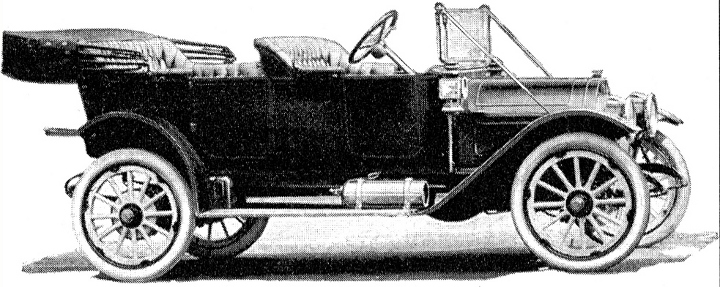 This article was taken from the October 2003 issue of Turning Wheels and details their trip from Eldora, IA to Los Angles, CA in a 1913 Studebaker. The only reference to the actual Studebaker Model, occurs on the first day when the author of the diary indicates the car was a 1913 Model 30. As Studebaker did not manufacture a Model 30 in 1913, we can assume either that the car was actually a Model 35, or that it was perhaps a left over 1912 Model 30 E-M-F, re-badged as a Studebaker. The only actual photo of the car in the Turning Wheel edition, was of very poor quality and thus was very limited as a item of identification. In any event, it makes little if any difference to the story as either car would have been very similar in design.
This article was taken from the October 2003 issue of Turning Wheels and details their trip from Eldora, IA to Los Angles, CA in a 1913 Studebaker. The only reference to the actual Studebaker Model, occurs on the first day when the author of the diary indicates the car was a 1913 Model 30. As Studebaker did not manufacture a Model 30 in 1913, we can assume either that the car was actually a Model 35, or that it was perhaps a left over 1912 Model 30 E-M-F, re-badged as a Studebaker. The only actual photo of the car in the Turning Wheel edition, was of very poor quality and thus was very limited as a item of identification. In any event, it makes little if any difference to the story as either car would have been very similar in design.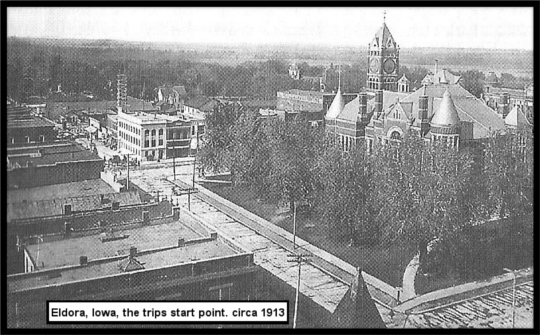
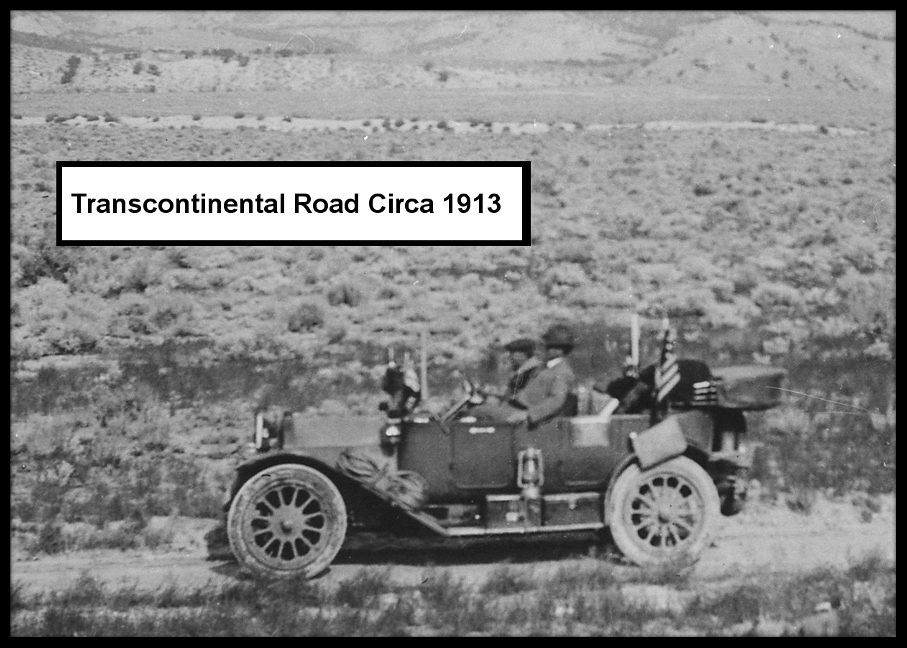
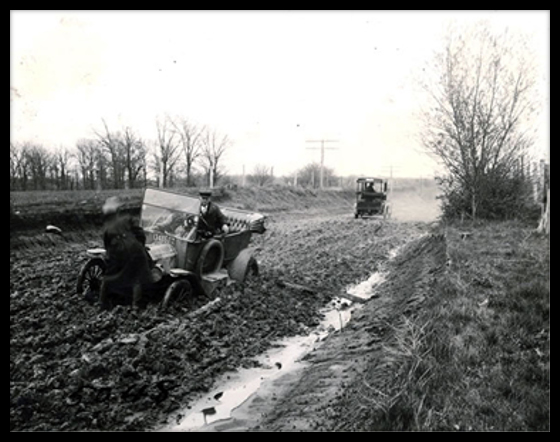 Utah (Olds’ Ranch, Fish Springs, Mud Flats, Kearney ‘s Ranch)
Utah (Olds’ Ranch, Fish Springs, Mud Flats, Kearney ‘s Ranch)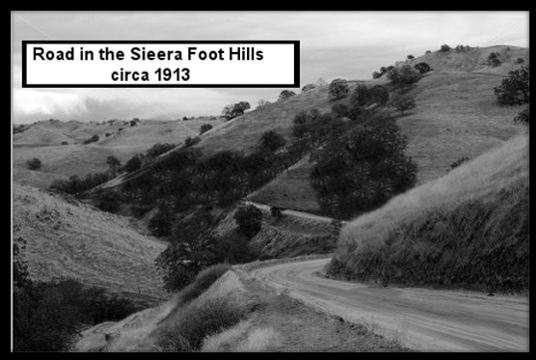
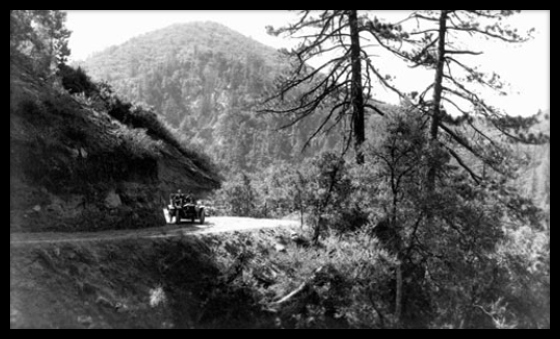 [Photo at the right: typical of the foot hills of the Sierra mountain’s and the road the Kneedler’s would have traveled. Photo left: A car very similar to the Kneedler’s Studebaker, negotiating a narrow mountain road]
[Photo at the right: typical of the foot hills of the Sierra mountain’s and the road the Kneedler’s would have traveled. Photo left: A car very similar to the Kneedler’s Studebaker, negotiating a narrow mountain road]